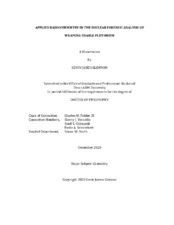| dc.description.abstract | Several forensic analyses have been performed on irradiated UO2 and weapons usable Pu to discriminate their origin and history. The discrimination techniques applied here may be used to aid intelligence officials in the investigation of proliferated special nuclear materials world-wide. Various radiochemical methods have been used to dissolve, separate, and characterize special nuclear materials to measure forensic signatures of interest to the discrimination process. The primary samples investigated were depleted UO2 containing fuel-grade Pu irradiated at the High Flux Isotope Reactor in Oak Ridge, TN, natural UO2 containing weapons-grade Pu irradiated at the University of Missouri Research Reactor in Columbia, MO, and four undocumented samples of super-grade Pu identified at Los Alamos National Laboratory in Los Alamos, NM.
Typical radiochemical techniques applied include acid digestions, ion exchange and extraction chromatographies, liquid-liquid extractions, mass spectrometry, and various forms of radiation detection. The principal forensic signatures investigated include isotope ratios of Pu, U, and the fission product elements, inter-elemental nuclide ratios of various chronometer pairs, and trace metal content. These signatures were used to discriminate the reactor origin and irradiation history of all primary materials; the chemical histories of the Pu samples from Los Alamos National Laboratory were also uncovered.
The applied radiochemical and forensic techniques were used to confirm the known origin and production date of the UO2 materials irradiated at the High Flux Isotope Reactor and the University of Missouri Research Reactor. Their possible origination from other similar nuclear reactors was excluded. The four undocumented Pu samples identified at Los Alamos National Laboratory were suspected to originate from the X-10 reactor during the Manhattan Project of the second World War. The forensic signatures available in these samples indicate they were produced and separated in the early days of weapons science between 1944 – 1954. One of these samples was specifically discovered to be among the first kilogram of Pu ever produced by humankind. | en |


